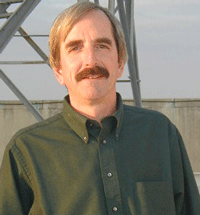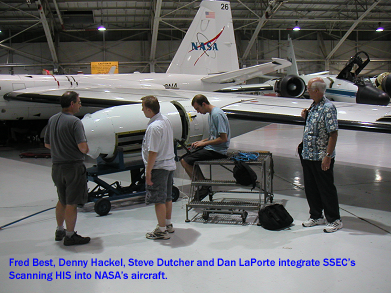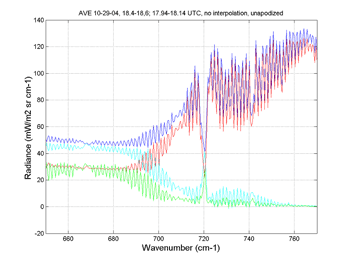Monthly News Summary – November 2004
SSEC Director Ready to Move Forward
Terri Gregory, Editor
This issue of In the News covers SSEC news and events from October 2004. Use images freely with credit to the Space Science and Engineering Center, University of Wisconsin–Madison.
Henry E. Revercomb |
Henry E. “Hank” Revercomb was named SSEC’s director on October 25. Revercomb, an SSEC scientist since 1972, had been acting as SSEC’s director since 1999 when Francis Bretherton retired from the position. When Revercomb announced to SSEC staff that he had accepted the permanent position, he said he believes that “this is a very exciting time for the center,” adding, “I pledge to do my part, in partnership with all of you, to push back the frontiers.”
Revercomb leads SSEC science activities, including those in his area of expertise, high-spectral instrument development. University Communications released the news; also, it was announced in the online campus publication,Wisconsin Week Wire on October 27 and in the official campus newspaperWisconsin Week for November 3.
Adventures in High Spectral Imaging
by Jennifer Ann O’Leary
In mid-October, the Scanning High-resolution Interferometer Sounder (S-HIS) bade farewell to Alaska and made the trek to Houston, Texas to collect data to validate NASA’s Aura satellite.
Developed at SSEC, the S-HIS uses a system of mirrors and calibration sources called black bodies to measure thermal radiation emitted from the earth at high spectral resolution (in the 3.3-18 micron range of the energy spectrum). Scientists use this information to determine temperature and water vapor profiles of the atmosphere.
In addition to gathering scientific data, field experiments also have an engineering component. “We build things in research centers and we test them, … more of an engineering purpose, to design a better instrument [to put in] space,” SSEC’s Executive Director for Science Tom Achtor said. Through field experiments, research centers like SSEC can demonstrate that “yes, this would be a good instrument to put out into space.”
Steve Dutcher, an associate instrument technician with SSEC’s Cooperative Institute of Meteorological Satellite Studies (CIMSS), has worked on several S-HIS field experiments, including the Aura Validation Experiment (AVE) in Houston. This mission will mark the first time that the instrument has flown in a WB-57. “This new integration we’re doing with the WB-57, assuming everything goes well, and I’m sure it will, that’ll probably mean another 3-4 missions,” Dutcher said.
In spite of his confidence, Dutcher mentioned a few potential problems the team could face. On past experiments, the acoustic noise and the vibrations inside the different aircraft interfered with S-HIS data collection. With the WB-57, Dutcher thought the power source on the plane would provide the largest obstacle. To accomadate, CIMSS technicians developed a power conditioning module and attached it to the S-HIS.
With the power problem preemptively solved, the test flights in late October went well. “Aircraft support … commented that we were the first instrument to ever plug in and just work,” Dutcher said. Science flights began in late October.
According to Joe Taylor, an assistant instrument innovator with SSEC, the power conditioning module gets the job done and will allow increased autonomy in future campaigns. “It works great. The power comes into that unit, is conditioned, and sent to our unit. [With this new module,] we are very independent of what platform we’re on … and what [the aircraft] provide[s],” Taylor said.
While in Alaska earlier this fall, the S-HIS accompanied a couple of other instruments from SSEC in accumulating data for the Mixed-Phase Arctic Cloud Experiment (M-PACE). This experiment sought to fill blanks in data gathered during a prior experiment that showed unique mixed-phase clouds dominating the Arctic’s low-cloud faction. Scientists hope the results from M-PACE will produce the comprehensive data set needed to analyze these clouds.
Before M-PACE, the S-HIS hung out in Italy then traveled to England. In Italy, S-HIS, accompanied by an SSEC science team, worked on the Aerosol Direct Radiative Impact EXperiment (ADRIEX). This experiment sought to analyze aerosol pollution caused by human activity. A Web site for Benevento, Italy prominently displays news of ADRIEX with a picture of Bill Smith, long-time SSEC collaborator, and the Proteus aircraft, which flew several instruments including the Scanning HIS. The Italian text refers to the collaboration of NASA, Wisconsin (SSEC) and Italy’s Mediterranean Agency for Remote Sensing. After gathering data for ADRIEX, the Scanning HIS went to England and flew in tandem with NASA’s NAST-I to validate the AIRS satellite as well as to calibrate and fine-tune both instruments.
Experiments like ADRIEX and the current campaign in Houston allow scientists to learn more about the atmosphere in specific places, to ensure the quality of satellite data and to fine-tune their own instruments. “Some of our best work gets down at these field experiments because you have no other distractions that you normally have here in the office and you’re working with all these different people and everybody’s really excited about their data,” Dutcher said. “The collaboration with the different groups and universities is really beneficial.”
Data and Imagery
Gigantic Computer Received—This past summer, SSEC’s CIMSS was awarded a sizable grant from the Navy’s DURIP program for computer hardware purchases. The main purpose of this hardware is to expand our modeling capabilities for hyperspectral research activities and related algorithm development. The core part of the system is an SGI Altix shared-memory computer running Linux.
The MODIS imagery server was temporarily disabled in mid-October, but was back in service on October 15. SSEC’s direct broadcast facility serves MODIS imagery to the public on a Gallery and on the direct broadcast page itself.
Science Experts
Making Satellite Data Useful—The National Research Council’s Space Studies Board Newsletter, July–September 2004, reports on work by the Committee on Environmental Satellite Data on Utilization of Operational Environmental Satellite Data: Ensuring Readiness for 2010 and Beyond. The committee, made up of experts from the user community and led by SSEC’s Allen Huang, appraised the ability of NASA and NOAA to handle vastly increasing data volumes. The committee presented several findings to help the agencies produce more useful data with its planned instruments.
Tropical Cyclones
CIMSS’ tropical cyclone research was mentioned in the October 20 issue ofWisconsin Week, the official campus newspaper, in the Almanac section. It was noted that “the researchers recorded, evaluated and imaged the action” of the deadly hurricanes that ravaged the U.S. east and southern coasts this hurricane season.
Weather Research
by Jennifer Ann O’Leary
Conversations about Forecasting—At the National Weather Association’s annual meeting in October, Gary Wade and Robert Aune (both in NOAA’s research group at SSEC) led a forum on the uses of satellite data. The forum served as a vehicle for an open discussion among users and providers to promote increased use of satellite data in operational weather forecasting. Operational weather forecasters from both the government and private sectors attended and discussed ways to improve the quality of the 24-hour forecast as well as how to help the average person understand the information such forecasts provide. They also talked about fog detection, scheduled outages, ways forecasting time can be used more efficiently, and how to improve warning lead times.
Forecasting Progress—The National Weather Service appointed Robert Aune (NOAA) as a member of the Mesoscale Analysis Committee (MAC). Assigned by the NWS to design a real-time surface analysis system to validate National Digital Forecast Database (NDFD) forecast grids, MAC met last week for the first time and came up with a plan to have a pilot system within the next six months.
Presenting…—The 25th Annual NOAA Climate Diagnostics and Prediction Workshop ran October 18–22 at Madison’s Monona Terrace Convention Center. Several of SSEC’s scientists presented posters. A couple covered work to come up with an improved version of the Advanced Very High Resolution Radiometer (AVHRR), a NOAA polar-orbiting weather satellite instrument. One of these posters featured an overview of the AVHRR Pathfinder Atmospheres Extended (PATMOS-x) project. The other displayed the project’s preliminary results. Tim Schmit (NOAA) presented a poster on GOES-R improvements for climate applications and Tony Schreiner (CIMSS) presented a poster titled “GOES Cloud products and Cloud Studies.”
Papers
The Pieces of a Forecast—Weather and Forecasting, a bimonthly journal from the American Meteorological Society, plans to publish a paper written by Tom Zapotocny (CIMSS), Paul Menzel (NOAA), James Jung (CIMSS) and James Nelson (CIMSS). The paper, titled “A Four Season Impact Study of Rawinsonde, GOES and POES Data in the Eta Data Assimilation System,” consists of two parts. Part one, “The Total Contribution,” looks at the collective contribution of the individual data sets and part two, “Contribution of the Components,” breaks down each contribution into its parts. The analysis presented in this paper concludes that each component positively contributes to 24-hour forecasts, rawinsonde data primarily for temperature forecasting, and GOES and POES primarily for wind and moisture.
Education, Outreach
Exchanging Outreach—Shelley Knuth of SSEC’s Antarctic Meteorological Research Center and Terri Gregory, SSEC’s public information coordinator, participated in a Science Alliance event to introduce other outreach specialists to their work. The UW Science Outreach Exchange was held Wednesday evening, October 27, at UW–Madison’s Biotechnology building. Sixteen university groups exhibited and shared appearances. Thanks to Dennis Shaffer, a reporter who attended the event, the event, and Shelley, were featured on 89.9 WORT-FM radio’s “Perpetual Notion Machine,” a biweekly show on science, on Thursday, November 4 at 7:30 p.m.
In the Wings
Writer Visits—Joel Swerdlow, this year’s science writer in residence at UW–Madison, will visit the Atmospheric, Oceanic and Space Sciences building on Monday, November 8. Room 823 is reserved for a brown bag lunch with Joel from 11:45 to about 12:30. Everyone who can fit into the room is invited. This visit will be followed by a short tour of SSEC.
Swerdlow is currently a freelancer based in Washington, D.C., has worked in broadcast and print, has taught at Johns Hopkins and other universities, consulted to the federal government and the media industry, has written and edited several books. He was an assistant editor and senior writer for National Geographic, where he served as lead writer for the magazine’s 1998-99 “Millennium” series.
Also of Note
Uncertainty Examined—The Madison Repertory Theater is performing the Tony Award-winning “Copenhagen,” by Michael Frayn through Sunday, November 14. The play deals with the 1941 visit of German atomic physicist Werner Heisenberg to Copenhagen where Niels Bohr, his Danish friend and former mentor, lived. Little is known about the visit; playwright Frayn considers the possibilities.
The Rep is producing the play under the auspices of the University of Wisconsin–Madison College of Letters and Science. The project is intended to inaugurate the World Year of Physics in 2005 and the centennial of Einstein’s “Miraculous Year,” in which he published several seminal papers that revolutionized the study of the physical world.
Educational activities surrounding the “Copenhagen” package culminate in a panel discussion, “The Influence of Science in the 21st Century” to take place on Tuesday, November 9, at 7 p.m. in the State Historical Society auditorium on Library Mall. The panel discussion, and all related educational events, are free and open to the public. For scheduling information, visit the physics department’s Web site. For “Copenhagen” ticket information, contact the Overture Center Box Office, (608) 258-4141.
Mars Featured—The magazine, Aviation Week and Space Technology, features recent unmanned exploration of Mars in its November 1 issue. The section offers a good summary of recent missions, with gorgeous landscape and Rover pictures.
Global Change and the Arctic—In an article on the Arctic effects of global change, MSNBC presents a good primer of the process. Easy-to-understand interactive graphics are sprinkled throughout the piece, which explains differences in policy and attitudes of the U.S. and other western nations. A forthcoming report from the Arctic Council, made up of the U.S. and other nations, warns that “the Arctic is warming almost twice as fast as the rest of the planet.” The scientific overview, written by 300 scientists, is to be released Monday, November 8.
Thanks this month for technical and content help to Tom Achtor, Bryan Baum, Steve Dutcher, Erik Olson and Joe Taylor.



